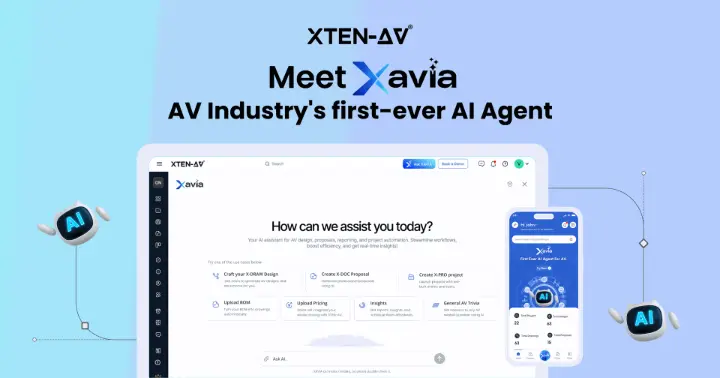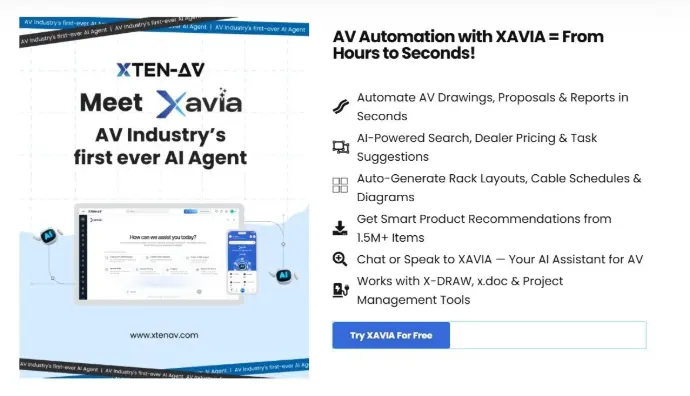For decades, proposal writing in the AV industry has been a time-consuming, manual process. From defining the scope of work to capturing product specifications and aligning pricing with dealer data — every step traditionally required hours of human effort. But the game has changed.
Enter XAVIA, a revolutionary AI-powered AV proposal software developed by XTEN-AV. XAVIA allows AV professionals to generate full, client-ready proposals in seconds using a simple voice or chat prompt. This is not a template-filling tool — it’s an intelligent automation platform that dynamically generates proposals based on real-time designs, BOMs, and pricing data.
In this detailed blog, we’ll explore how XAVIA automates proposal generation, why it’s disrupting the status quo, and how it works with your existing AV system integration software to streamline every part of your client engagement process.

Why Traditional AV Proposal Workflows Are Broken
1. Time-Consuming Templates
Traditional proposal workflows in the AV industry rely heavily on static templates that require extensive manual editing. Each new project means reformatting pages, updating line items, and customizing design language to meet client expectations — a process that often leads to formatting inconsistencies and overlooked details. These repetitive, low-value tasks drain valuable engineering and sales time, slowing down the proposal cycle significantly. When deadlines are tight and first impressions count, relying on outdated templates can cause a company to fall behind competitors with more agile, modern solutions.
2. BOM and Design Disconnects
In conventional AV workflows, BOM creation and design documentation are usually handled in separate tools — with proposals being drafted independently of both. This siloed approach introduces a dangerous margin for error. A proposal may reflect outdated product selections or pricing that doesn’t match the most current system design. This disconnect often leads to confusion during client presentations, internal misalignment between teams, and ultimately project delays or rework. Synchronizing these elements manually is not just tedious — it’s a process that no longer belongs in the digital era.
3. Error-Prone Manual Calculations
AV proposals often include complex pricing structures, detailed labor estimates, and variable tax implications. When handled manually, these calculations are vulnerable to misentry, formula errors, or incorrect versioning. A single mistake in a pricing table can not only harm credibility with the client but also lead to costly financial discrepancies for the integrator. Furthermore, the lack of dynamic validation in traditional spreadsheets means that errors go undetected until it’s too late, increasing the risk of project margin loss and reputation damage.
4. Slow Turnaround = Lost Deals
In a competitive AV bidding environment, speed matters. Clients evaluating multiple vendors often award the contract to the team that delivers a professional, detailed, and timely proposal. With traditional tools, turnaround time can stretch into days — giving faster competitors a clear advantage. AV firms still relying on fragmented workflows and manual processes are simply unable to compete on speed without sacrificing quality. And in an age of real-time expectations, being late with a proposal often translates directly to being out of the running.
5. Lack of Personalization
Clients expect tailored solutions that speak directly to their industry, use case, and vision. Traditional proposal templates tend to follow a one-size-fits-all format, often resulting in documents that appear generic or uninspired. Without dynamic customization, these proposals fail to reflect the unique value the AV firm offers — making it harder to stand out from competitors. A lack of personalization undermines the consultative nature of AV sales and makes it more difficult to close deals, particularly in sectors where trust and relevance are key to conversion.
What Is XAVIA?
XAVIA is the first AI agent designed specifically for the AV industry. Its proposal generation capability allows users to create customized, client-ready proposals based on real-time BOM, design, and project data — all through a single voice or chat command.
Key Capabilities:
- Voice/chat-based proposal creation
- Auto-insertion of scope, pricing, and specs
- Dealer pricing integration
- Revision tracking and version control
- Export in branded templates (PDF, DOCX)
The Importance of AI-Generated AV Proposals
1. Speed and Efficiency
One of the biggest advantages of AI-generated AV proposals is the dramatic increase in speed. Instead of spending hours manually compiling technical specs, pricing, and formatting, XAVIA can deliver a comprehensive, client-ready proposal in seconds. This time savings isn’t just convenient — it’s a competitive advantage. In a fast-paced bidding environment, being able to respond to leads and RFPs rapidly can make the difference between closing a deal or losing it. Speed also empowers smaller AV teams and independent consultants to handle a higher volume of projects without sacrificing quality or missing deadlines.
2. Accuracy and Consistency
Manual proposal generation is prone to errors, especially when data is being copied and pasted between different platforms like spreadsheets, CAD drawings, and Word documents. XAVIA’s AI-driven engine eliminates those issues by dynamically pulling data from synced BOMs, live dealer pricing sheets, and system integration platforms. Every proposal is built with consistency in mind — aligned with the current system design and up-to-date pricing, with no manual intervention required. This ensures that what’s proposed is exactly what gets installed, improving client trust and internal execution.
3. Client Confidence
First impressions matter, and a polished, well-structured proposal speaks volumes about your professionalism and attention to detail. With XAVIA, every proposal is branded, visually appealing, and formatted to highlight your AV expertise. The inclusion of accurate product descriptions, visuals, and clearly stated value propositions enhances credibility. Customization features also allow for personalized greetings, vertical-specific layouts, and project-specific references — making the client feel seen and understood. The result? A stronger sense of confidence in your firm and a higher likelihood of contract approval.
4. Boost Sales Conversion Rates
Speed and accuracy don’t just streamline operations — they drive revenue. When you can respond faster to RFPs with polished, compelling proposals, your close rates naturally improve. AI-generated proposals also allow for better follow-up and client interaction, since everything is traceable, consistent, and easy to explain. Sales teams can focus more on building relationships rather than rechecking documents for errors or updates. This efficiency ultimately shortens the sales cycle, increases client responsiveness, and positions your AV business as a responsive, modern partner worth choosing.
5. Enable Scalable Operations
Whether you’re a small integration firm or an enterprise-level AV provider handling hundreds of proposals per month, scalability is key. Traditional proposal methods simply don’t scale efficiently — you’d need to hire more personnel or sacrifice quality. XAVIA solves this problem by making high-volume, high-quality proposal generation possible without expanding your team. With automation at the core, every proposal follows your branding, your pricing, and your processes — whether you're building one or one hundred in a week. It’s a foundation for sustainable growth.
How XAVIA Creates Proposals in Seconds
Step 1: Voice or Chat Prompt
The process begins with a simple voice or chat command, eliminating the need to open multiple software tools or documents. For example, a user might say, "Generate a proposal for a 10-seat conference room AV upgrade with dual displays and wireless presentation." XAVIA’s natural language processing capabilities interpret the command and begin gathering all relevant data. Whether you’re at your desk or on a job site, this interface allows AV professionals to initiate proposal creation in real time, making it easy to respond quickly to client requests and RFPs without delay.
Step 2: Pulls From BOM and Design
Once the command is received, XAVIA immediately taps into its integrated data sources — including your most recent Bill of Materials (BOM) and AV system design files. It extracts the appropriate product list, quantity breakdowns, and any room-specific configurations such as layout details or signal flow requirements. It also checks equipment compatibility to ensure that the proposed solution is technically viable. By automating this connection, XAVIA ensures that proposals are always aligned with the latest design specifications, eliminating the version control issues that plague manual workflows.
Step 3: Applies Dealer Pricing
With the product and design data in place, XAVIA automatically applies up-to-date pricing using your dealer-specific pricing sheets. This live integration means the system fetches real-time costs based on your contracts and vendor relationships. You no longer have to manually look up prices or worry about outdated numbers from old spreadsheets. If a certain item is out of stock or has alternative options available, XAVIA will recommend substitutions. This ensures financial accuracy and helps teams avoid quoting errors that could impact margin or require client re-approvals later on.
Step 4: Builds Branded Proposal
After assembling the design and pricing data, XAVIA formats everything into a clean, professional proposal using your company’s branding. Each proposal includes key components such as Scope of Work, Technical Specifications, a detailed Pricing Table, and Terms & Conditions. Additionally, it offers the ability to include optional upsells or alternate configurations tailored to client interests. This intelligent packaging allows AV professionals to present a compelling narrative that highlights value, addresses client needs, and reinforces brand consistency across every document — without requiring design or copywriting skills.
Step 5: Allows Revision and Export
Before final delivery, XAVIA allows you to revise the proposal using either voice commands or manual edits. You can update language, adjust pricing, tweak formatting, or add client-specific notes. Once finalized, the proposal can be exported in multiple formats including PDF, DOCX, or directly into cloud-based proposal tools. It also supports integrations with e-signature platforms, making it easier than ever to close deals fast. With version control and history tracking included, every change is logged for accountability, ensuring a smooth transition from sales to project execution.
Integration With AV System Integration Software
XAVIA plays well with your existing stack.
Seamless Compatibility:
- Pull design data from CAD/Revit/Visio
- Sync BOMs with product databases
- Integrate with CRMs like HubSpot, Salesforce
- Proposal export to Docusign, PandaDoc, or custom tools
This ensures a true end-to-end AV workflow — from first sketch to signed proposal.
Case Studies: Winning Proposals in Seconds
📌 Case Study 1: Enterprise AV Firm
- Challenge: Long proposal cycles losing competitive bids
- Result: With XAVIA, created 20+ proposals per week with 3x increase in win rate
📌 Case Study 2: Freelance AV Consultant
- Challenge: No dedicated proposal resource
- Result: Uses voice prompts to generate proposals solo — saving 10+ hours/week
📌 Case Study 3: Multi-Location Integration Company
- Challenge: Needed consistency across distributed sales teams
- Result: XAVIA ensures every proposal follows the same structure and branding
Users Also Ask (FAQs)
1. What data does XAVIA use to generate proposals?
XAVIA pulls from BOMs, design specs, pricing sheets, and previous proposal templates.
2. Can I generate proposals from my mobile?
Yes. XAVIA is mobile-optimized for field and remote use.
3. Does XAVIA support multiple proposal templates?
Yes. You can store and choose from branded, vertical-specific formats.
4. Can I customize the proposal after AI generates it?
Absolutely. Manual edits and voice updates are supported.
5. Is XAVIA secure for proposal data?
Yes. All data is encrypted and access-controlled.
6. Does it handle upsell and alternate pricing options?
Yes. XAVIA can suggest upgrades and present option pricing to clients.
7. Can it track revisions or client views?
Yes. Version control and engagement tracking are built in.
8. Does it integrate with signature tools?
Yes. XAVIA supports integrations with e-signature platforms.
Conclusion: The New Standard in Proposal Automation
XAVIA is not just a proposal tool — it’s a sales accelerator for the AV industry. With the power of AI-powered AV proposal software, your team can respond faster, more accurately, and more professionally to every opportunity.
Whether you're chasing a school retrofit, an enterprise upgrade, or a hospitality AV overhaul — XAVIA ensures your proposal is ready before your competitors open PowerPoint.
Proposals in seconds. Confidence in every bid. Only with XAVIA.
Start writing here...
